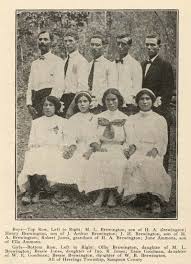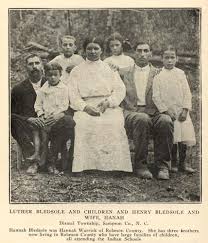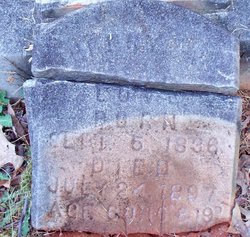PIn the 1850 census, Wolf Pit Township, Richmond County, North Carolina in Household #476 is the family of Ervin and Charity Love. Ervin Love is listed as 35 years old, a laborer and his race is listed as black. His wife Charity is listed as 40 years old and her race is listed as mulatto. Also living in the household is Charity's mother, Sallie Freeman, who is 60 and also listed as mulatto. There are 5 sons in the household of Ervin and Charity: Isaac, 16, Henry 14, James 12, Louie 8, and Thomas 5. Also, nearby is the oldest son John Love, 21, working for an Attorney, John Cameron, as a laborer. All of the sons are listed as black.
Twenty years later, in 1870, in Stanly County, North Carolina, the widow Priscilla Murray, aka Prussia, will be counted with her 3 year old daughter Matilda. Priscilla was rumoured to be an Indian, but accepted as part of the white community, as her husband Henry Garner Aldridge, was white. Matilda will be listed as mulatto for the rest of her life. Matilda was born 5 years after the death of Garner Aldridge and was an Aldridge in name only. In 1873, at the age of 5, she is bound to Henry Love, to learn the art of housekeeping.
There are 4 interesting observations about the 1850 census of Wolf Pit Township:
http://www.ncgenweb.us/richmond/1850wolfpit.htm
1) About 50% of the households are listed as mulatto.
2) A large number of professionals; doctors, lawyers, tradesmen, are in the area, which indicates a town forming.
3) Several carpenters and labourers are in the area, meaning things are being constructed.
4) There are a number of settlers listed as having been born in Scotland.
Also significant is the fact that Richmond County is next to Scotland County and part of the Carolina Sandhills, along with Cumberland County (Fayetteville) and Robeson County (Lumberton).
This link provides a map showing areas within 25 miles of Wolf Pit. Notice Albemarle (Stanly County) to the North, Fayetteville to the East and Lumberton to the Southeast.
http://www.ourfamtree.org/radius.cfm/state/NC/county/Richmond%20Co/city/Wolf%20Pit/id/19427

The early censuses of Sampson County notate that the county had a large number of 'Croatan Indians' in the area and that they were typically counted as Mulatto or considered "Free People of Color."
One of the most important things about the 1850 census of Wolf Pit is that it was taken in the year 1850, before the Civil War and emancipation. The families listed as black or mulatto were not slaves. People who had been slaves were not listed in the 1850 census, but were counted instead in a 'Slave Schedule'.
In Wolfpit, some families carried individuals listed as different races. It is if the census takers judged them, not by their ethnic inheritance, but just by the darkness or lightness of their skin. Several of the names in the area during this time: Chavis or Chavers, Jacobs, Locklear, are associated with the Lumbee tribe, the name taken from the Lumbee river, until this day. It is clear that the families listed as people of color in the 1850 census were not Africans or mulattos, but were 'Croatans' or Native Americans. The census takers did not have a slot to put them in and truly did not know what to do with them.
 They were not black, but neither were they white, and indeed, there had been decades, even centuries of admixture in their ancestory. They were even rumoured to be descendants of the Lost Colony. The story goes that Scotch settlers stumbled upon a tribe of Indians living along the Lumber River inland, during the 1730's, using English building methods, some speaking words of broken English and even as being a 'mixt' lot, some having lighter hair or blue or grayish eyes. Several members of the early Lumbee tribe were also known to intermarry with African-Americans. The mulatto residents of Wolfpit echoed the same theme found in the Murray/Pearce-Pierce family, the Hedgepeths, the Bass and the Manuels, a trifecta of Scottish/Native American and African ancestry.
They were not black, but neither were they white, and indeed, there had been decades, even centuries of admixture in their ancestory. They were even rumoured to be descendants of the Lost Colony. The story goes that Scotch settlers stumbled upon a tribe of Indians living along the Lumber River inland, during the 1730's, using English building methods, some speaking words of broken English and even as being a 'mixt' lot, some having lighter hair or blue or grayish eyes. Several members of the early Lumbee tribe were also known to intermarry with African-Americans. The mulatto residents of Wolfpit echoed the same theme found in the Murray/Pearce-Pierce family, the Hedgepeths, the Bass and the Manuels, a trifecta of Scottish/Native American and African ancestry. 
In the Wolf Pit Township, Richmond County, North Carolina household #476, we find the first mention of Henry Love.
Also, nearby is a 21 year old John Love, mulatto, laborer, living in the household of a lawyer, John Cameron.
In 1860, Henry is working in the Turpentine industry and boarding with a Smith family.
He married Sarah in 1853, and his marriage license is on file. Remember that the year is 1853, prior to the Civil War. If he were a slave or descendant of slaves, his marriage license would not be on file or recorded, except perhaps in the diary of one of the family members he worked for. These were free persons, of equal status to whites. Ervin Love may have been the son of a Croatan mother and a black man, as children took the status of the mother. If she was free, so was the child, but they were still members of the tribe.
Henry was a blacksmith. He even served in the Civil War. Lumbees did fight for the Confederacy. African-Americans did not. There were African units in the Union Army, but not the Conferate Army.
In the 1880 census, the transcribers got it wrong. Looking at the original document, the last Long listed is James, with Long beside his name. They have Matilda listed as Matilda _ ( a dash), they did not record her surname at all. And Harriett, Sarah's mother, her surname is clearly Little on the original document. Why they made her a Long, I don't know. But the death certificate of Jonah, son of Henry and Sarah confirms that his mother's maiden name was Little.
Henry is buried in Locust, Stanly County, NC at the AME Zion Church.

Twenty years later, in 1870, in Stanly County, North Carolina, the widow Priscilla Murray, aka Prussia, will be counted with her 3 year old daughter Matilda. Priscilla was rumoured to be an Indian, but accepted as part of the white community, as her husband Henry Garner Aldridge, was white. Matilda will be listed as mulatto for the rest of her life. Matilda was born 5 years after the death of Garner Aldridge and was an Aldridge in name only. In 1873, at the age of 5, she is bound to Henry Love, to learn the art of housekeeping.
There are 4 interesting observations about the 1850 census of Wolf Pit Township:
http://www.ncgenweb.us/richmond/1850wolfpit.htm
1) About 50% of the households are listed as mulatto.
2) A large number of professionals; doctors, lawyers, tradesmen, are in the area, which indicates a town forming.
3) Several carpenters and labourers are in the area, meaning things are being constructed.
4) There are a number of settlers listed as having been born in Scotland.
Also significant is the fact that Richmond County is next to Scotland County and part of the Carolina Sandhills, along with Cumberland County (Fayetteville) and Robeson County (Lumberton).
This link provides a map showing areas within 25 miles of Wolf Pit. Notice Albemarle (Stanly County) to the North, Fayetteville to the East and Lumberton to the Southeast.
http://www.ourfamtree.org/radius.cfm/state/NC/county/Richmond%20Co/city/Wolf%20Pit/id/19427

The early censuses of Sampson County notate that the county had a large number of 'Croatan Indians' in the area and that they were typically counted as Mulatto or considered "Free People of Color."
One of the most important things about the 1850 census of Wolf Pit is that it was taken in the year 1850, before the Civil War and emancipation. The families listed as black or mulatto were not slaves. People who had been slaves were not listed in the 1850 census, but were counted instead in a 'Slave Schedule'.
In Wolfpit, some families carried individuals listed as different races. It is if the census takers judged them, not by their ethnic inheritance, but just by the darkness or lightness of their skin. Several of the names in the area during this time: Chavis or Chavers, Jacobs, Locklear, are associated with the Lumbee tribe, the name taken from the Lumbee river, until this day. It is clear that the families listed as people of color in the 1850 census were not Africans or mulattos, but were 'Croatans' or Native Americans. The census takers did not have a slot to put them in and truly did not know what to do with them.
In the Wolf Pit Township, Richmond County, North Carolina household #476, we find the first mention of Henry Love.
#476 Ervin Love, 35m, black, laborer, NC Charity Love, 40f, mulatto, NC Isaac Love, 16m, mulatto, laborer, NC Henry Love, 14m, black, NC James Love, 12m, black, NC Louis Love, 8m, black, NC Sallie Freeman, 60f, mulatto, NC Thomas Love, 5m, black, NC
Also, nearby is a 21 year old John Love, mulatto, laborer, living in the household of a lawyer, John Cameron.
In 1860, Henry is working in the Turpentine industry and boarding with a Smith family.
| Name: | Henry Love | ||||||||||||||||||
|---|---|---|---|---|---|---|---|---|---|---|---|---|---|---|---|---|---|---|---|
| Age in 1860: | 25 | ||||||||||||||||||
| Birth Year: | abt 1835 | ||||||||||||||||||
| Birthplace: | North Carolina | ||||||||||||||||||
| Home in 1860: | Wolf Pitt, Richmond, North Carolina | ||||||||||||||||||
| Race: | Black | ||||||||||||||||||
| Gender: | Male | ||||||||||||||||||
| Post Office: | Rockingham | ||||||||||||||||||
| Value of real estate: | View image | ||||||||||||||||||
| Household Members: |
| ||||||||||||||||||
He married Sarah in 1853, and his marriage license is on file. Remember that the year is 1853, prior to the Civil War. If he were a slave or descendant of slaves, his marriage license would not be on file or recorded, except perhaps in the diary of one of the family members he worked for. These were free persons, of equal status to whites. Ervin Love may have been the son of a Croatan mother and a black man, as children took the status of the mother. If she was free, so was the child, but they were still members of the tribe.
| Name: | Henry Love |
|---|---|
| Gender: | Male |
| Race: | Black |
| Spouse: | Sarah Love |
| Spouse Gender: | Female |
| Spouse Race: | Black |
| Marriage Date: | 1853 |
| Marriage County: | Union |
| Marriage State: | North Carolina |
Henry was a blacksmith. He even served in the Civil War. Lumbees did fight for the Confederacy. African-Americans did not. There were African units in the Union Army, but not the Conferate Army.
| Name: | Henry D Love |
|---|---|
| Residence: | Rockingham County, North Carolina |
| Occupation: | Blacksmith |
| Age at enlistment: | 28 |
| Enlistment Date: | 22 May 1861 |
| Rank at enlistment: | Private |
| Enlistment Place: | Rockingham County, NC |
| State Served: | North Carolina |
| Survived the War?: | Yes |
| Service Record: | Enlisted in Company K, North Carolina 13th Infantry Regiment on 22 May 1861. Mustered out on 07 Dec 1864. Transferred to on 07 Dec 1864. |
| Birth Date: | abt 1833 |
| Sources: | North Carolina Troops 1861-65, A Roster |
| Name: | Henry W. Love | ||||||||||||||||||||||
|---|---|---|---|---|---|---|---|---|---|---|---|---|---|---|---|---|---|---|---|---|---|---|---|
| Age: | 44 | ||||||||||||||||||||||
| Birth Year: | abt 1836 | ||||||||||||||||||||||
| Birthplace: | North Carolina | ||||||||||||||||||||||
| Home in 1880: | Furrs, Stanly, North Carolina | ||||||||||||||||||||||
| Race: | Black | ||||||||||||||||||||||
| Gender: | Male | ||||||||||||||||||||||
| Relation to Head of House: | Self (Head) | ||||||||||||||||||||||
| Marital Status: | Married | ||||||||||||||||||||||
| Spouse's Name: | Sarah Love | ||||||||||||||||||||||
| Father's Birthplace: | Virginia | ||||||||||||||||||||||
| Mother's Birthplace: | North Carolina | ||||||||||||||||||||||
| Neighbors: | View others on page | ||||||||||||||||||||||
| Occupation: | Farmer | ||||||||||||||||||||||
Cannot read/write:
Blind: Deaf and dumb: Otherwise disabled: Idiotic or insane: | |||||||||||||||||||||||
| Household Members: |
|

| Birth: | Sep. 5, 1836 |
| Death: | Jul. 24, 1897 |
| Burial: Brown Hill AME Zion Church Cemetery Locust Stanly County North Carolina, USA | |
Edit Virtual Cemetery info [?] | |
Created by: William Poplin Record added: Nov 20, 2010 Find A Grave Memorial# 61920087 | |


 You can see the village of Cordova indicated on the map south of Rockingham and the proximity to the Anson county communities of Lilesville and PeeDee. For large families like that of Philmore Carpenter, or for the fatherless ones like that of Ann Howell, the burgeoning industry of textile mills was a source of income and survival. Prolific, but unindustrious Philmore, sent his bounty of children to work in the mills, which could supplement his alchohol addiction and lack of sucess as a farmer. Other families, like the Coxes, did not own enough land to provide a substatial living. To other families along the Yadkin and PeeDee rivers in Montgomery and further south, on into South Carolina, the building of the damns had flooded much of their property and especially their fertile bottomlands, laying their farms underwater, or the back up from the flooding causing an outbreak of malaria and other diseases. Many of these displaced families sought work in the factories, and many sought a healthier existence away from the water and mosquitoes.
You can see the village of Cordova indicated on the map south of Rockingham and the proximity to the Anson county communities of Lilesville and PeeDee. For large families like that of Philmore Carpenter, or for the fatherless ones like that of Ann Howell, the burgeoning industry of textile mills was a source of income and survival. Prolific, but unindustrious Philmore, sent his bounty of children to work in the mills, which could supplement his alchohol addiction and lack of sucess as a farmer. Other families, like the Coxes, did not own enough land to provide a substatial living. To other families along the Yadkin and PeeDee rivers in Montgomery and further south, on into South Carolina, the building of the damns had flooded much of their property and especially their fertile bottomlands, laying their farms underwater, or the back up from the flooding causing an outbreak of malaria and other diseases. Many of these displaced families sought work in the factories, and many sought a healthier existence away from the water and mosquitoes.